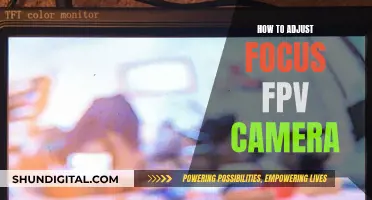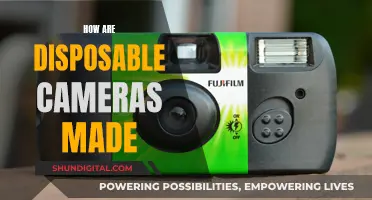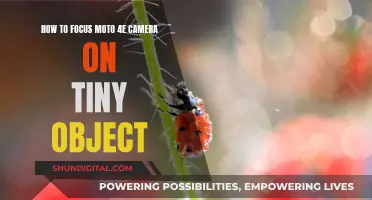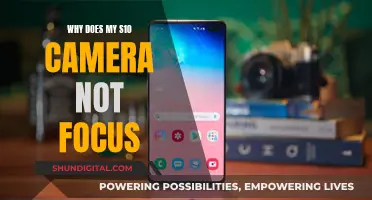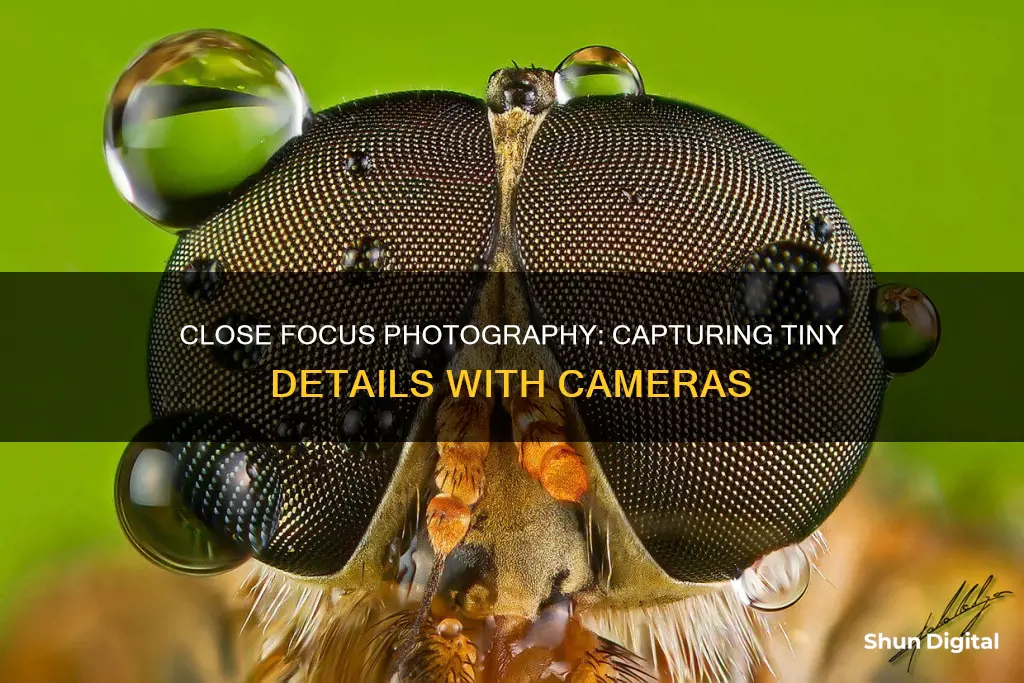
Close focus refers to the minimum distance at which a camera can focus on an object. This distance varies depending on the camera and lens being used. Modern cameras have autofocus capabilities, which use a motor in the camera or lens to focus on a subject. Autofocus tends to be faster and more accurate than manual focus, especially when tracking moving objects. However, manual focus can be useful in low-light conditions or when precise adjustments are required. Close focus is particularly important in applications such as robotics, medical imaging, and machine vision, where fine details of objects located very close to the camera need to be captured.
| Characteristics | Values |
|---|---|
| Definition | The minimum distance at which the camera can focus and capture a sharp image of an object |
| Other names | Minimum shooting distance, closest focus distance |
| Importance | Allows the camera to capture fine details of objects that are located at a very short distance from the camera |
| Use case | Applications where close-focus imaging is required, e.g. quality control, robotics, medical imaging, machine vision |
| Effect on image | Determines how close you can get to your subject while still being able to capture a clear and detailed image |
| Autofocus | If you try to focus on an object that is closer than the minimum focus distance, the camera will struggle to autofocus or produce blurry results |
| Zoom block cameras | Can be set to a minimum focus distance of 10mm (0.39 inches) |
| Extension tubes | Supplemental lenses that can be mounted before the lens to allow for closer focusing |
| Close-up lenses | Can be used to focus on objects as close as 330mm (13 inches) |
What You'll Learn

Minimum focus distance
The minimum focus distance is an important specification, particularly when close-focus imaging is required. It determines how close you can get to your subject while still being able to capture a clear and detailed image.
If you try to focus on an object that is closer than the minimum focus distance, your camera will likely struggle to autofocus, resulting in blurry images. This can be a challenge when capturing images in confined spaces, as you will inevitably be physically close to the subject while trying to maintain focus.
The minimum focus distance is a property of the lens rather than the camera. Different lenses have different minimum focus distances, and this information can be found in the lens specifications provided by the manufacturer.
There are ways to achieve a shorter minimum focus distance. One method is to use a dedicated macro lens, which is specifically designed for close-up photography. Macro lenses have a shorter minimum focus distance, allowing you to get closer to your subject while maintaining sharp focus.
Another approach is to use extension tubes, which are placed between the lens and the camera body. These tubes effectively increase the distance between the lens and the image sensor, resulting in a shorter minimum focus distance.
By understanding the concept of minimum focus distance and utilising the appropriate equipment, photographers can effectively capture clear and detailed images, even in situations where close-up photography is required.
Focusing on Yourself: Self-Portrait Camera Techniques
You may want to see also

Zoom block cameras
In photography, the minimum focus distance refers to the minimum distance at which a camera can focus and capture a sharp image of an object. Zoom block cameras are a diverse group and can be custom-designed with add-on components and assemblies. They are known for their exceptional precision in imaging, with some offering up to 40x zoom capabilities. This makes them perfect for detailed observation across various fields, from monitoring wildlife to inspecting machinery.
One example of a zoom block camera is the Sony FCB-EV7520, a 30x Zoom Full HD Block Camera. It can capture crisp, clear Full HD (1080/60p) images with a rapid 30x optical zoom. The minimum object distance for this camera is 10mm at the wide end and 1200mm at the tele end, with a default of 300mm.
Videology also offers zoom block cameras with autofocus capabilities and improved close-focus performance. Their 10x Autofocus Zoom Block Camera line has a minimum focus distance of 10mm (0.39 inches), which can be further decreased through firmware adjustment to as low as 0.39 inches, allowing for better close-focus performance. These cameras are often used in applications such as quality control, robotics, medical imaging, and machine vision, where accurate close-focus imaging is crucial.
With their powerful zoom and focus capabilities, zoom block cameras have become invaluable tools in various industries, enabling users to capture clear and detailed images, even in confined or challenging environments.
Polaroid Cameras: Where Are They Manufactured?
You may want to see also

Manual vs autofocus
The main difference between manual and autofocus is that manual focus leaves the focusing to the user, while autofocus lets the camera take control. Autofocus is generally faster and is useful when shooting very fast-moving subjects, or when working alone. Autofocus also has the advantage of tracking, which enables it to lock focus on a subject and track it through the frame.
Manual focus, on the other hand, gives the photographer greater creative control. It is ideal for situations where autofocus may struggle, such as low-light conditions, shooting magnified scenes, or taking shots through glass or fences. It is also more precise, allowing the photographer to carefully pick the point of focus from a chaotic scene.
In terms of close-up photography, autofocus can struggle at high magnifications and will often fail to focus, hunting back and forth. Manual focus is therefore recommended for macro photography, as it is more precise and easy to use when picking out objects of interest.
The choice between manual and autofocus ultimately depends on the photographer's needs and shooting conditions.
Portait Mode on Galaxy S7 Edge: Where and How?
You may want to see also

Phase detection vs contrast detection
The minimum focus distance of a camera refers to the minimum distance at which the camera can focus and capture a sharp image of an object. This is an important specification, especially for close-up or macro photography, where the camera needs to capture fine details of objects located very close to the lens.
Now, let's delve into the differences between phase detection autofocus (PDAF) and contrast detection autofocus (CDAF) systems:
Phase Detection Autofocus (PDAF)
PDAF is a technology that uses two sensors located on each side of the camera lens to detect the phase difference of the incoming light. This allows the camera to determine whether the subject is in focus or not, and it adjusts the lens accordingly. PDAF is known for its speed and accuracy, especially when tracking moving subjects. It is commonly found in digital SLRs and some mirrorless cameras. One of its advantages is that it performs well in low-light conditions because the phase detection sensors can detect light directly from the lens. Additionally, PDAF offers customisation options, allowing photographers to change focus points and sensitivity to suit their preferences.
Contrast Detection Autofocus (CDAF)
On the other hand, CDAF uses the camera's sensor to detect the contrast between light and dark areas within the scene. The camera's processor then analyses this information and adjusts the lens to bring the subject into focus. CDAF is commonly found in mirrorless cameras and some point-and-shoot cameras. One of the key advantages of CDAF is its accuracy when focusing on stationary subjects, making it ideal for portrait and landscape photography. It is also quieter than PDAF, which is beneficial when photographing skittish animals or working in quiet environments.
Hybrid Autofocus Systems
With advancements in camera technology, some mirrorless cameras now offer hybrid autofocus systems that combine both PDAF and CDAF. This provides photographers with greater versatility, allowing them to track moving subjects using phase detection and focus sharply on stationary subjects using contrast detection.
In conclusion, the choice between PDAF and CDAF depends on the type of photography you enjoy and the camera you are using. Both systems have their strengths and weaknesses, so it is essential to understand their differences to make an informed decision before your next camera purchase.
Forester Rear Camera Diagnostics: How to Access?
You may want to see also

Macro photography
The technical definition of macro photography states that the subject's size on the image sensor must be life-size or greater. However, in a broader sense, it can refer to any finished photograph where the subject appears larger than its real-life size. The ratio of the subject's size on the sensor to its actual size is known as the reproduction ratio, and a macro lens typically has a reproduction ratio of at least 1:1.
Another technique for achieving macro photography is to use extension tubes or bellows to increase the distance between the lens and the image sensor, resulting in greater magnification. Additionally, auxiliary close-up lenses or "filters" can be attached to the front of the camera lens to enable close focusing.
With the right skills and equipment, macro photography allows photographers to explore an alien world, revealing fascinating textures and details that are usually invisible to the naked eye.
Portrait Mode: Which Cameras Have This Feature?
You may want to see also
Frequently asked questions
Close focus refers to the minimum distance at which a camera can focus on an object and capture a sharp image. This is also referred to as the "minimum shooting distance" or "minimum focus distance". The shorter the minimum focus distance, the closer you can get to your subject while still capturing a clear image.
Minimum focus distance is particularly important in applications such as quality control, robotics, medical imaging, and machine vision, where capturing fine details of objects at very short distances is crucial. It also comes in handy when working in confined spaces, as it allows you to maintain focus while being physically close to the subject.
Achieving close focus depends on the capabilities of your camera and lens. Some cameras and lenses are specifically designed for macro photography, allowing for shorter minimum focus distances. You can also use techniques such as extension tubes or close-up lenses to achieve closer focusing. Additionally, understanding the concept of the plane of focus and utilising autofocus or manual focus can help you capture sharp images at close range.


